Basics
Home and SearchSite Guide
Brentford Basics
Privacy Policy
Contact
People
FamiliesPhotos of people
Name indexes incl WW1
Memories
Lists, Documents, News
Occupations
Properties
Properties: High StreetProperties: non-High Street
Photos
Maps
1909/10 Valuation Index
Pub Hub
Can You Help?
Seeking...Mystery photos
Roads Off
A-Z listJanet's Research
HistoryBeach's Jam
Nowell Parr
Turner the Artist
Queen Victoria 1840
Brentford Market
80 High Street
Clitherow of Boston House
Four Croxford Brothers
Sources & More
They SaidBooks etc.
Web Links
Next
Site Technology
Author
Home and Search
Not Brentford
MARKETS AND GROWERS
Author: Janet McNamara.
This includes the following images:
- Magistrates Court in the Market Place, 2002 (Janet McNamara)
- The White Horse, Market Place, 2002 (Janet McNamara)
- Entrance from the back of the Market Place to The Butts, 2002 (Janet McNamara)
- Postcard view of Market Place fair, 1905 (postcard)
- Market Place and Market House, New Brentford Tithe Map, 1838 (Corporation of London, London Metropolitan Archives)
- Market Place and Town Hall, ca 1908 (postcard)
- Market carts at Kew Bridge site, 1892/3 (Chiswick Public Library)
- Detail of griffins over the Market entrance, 1972 (Chiswick Public Library)
- Market interior, late 1960s / early 1970s (Chiswick Public Library)
- 1893 Market frontage, photographed in 1976 (Chiswick Public Library)
- 1877 Fountain, Kew Bridge, 2009 (Janet McNamara)
The beginnings of Brentford Market
There are several reasons for the growth of a market town such as Brentford during medieval times. Good communication routes by road and river were an important necessity, also a suitable site, the interest of those in authority and an area to provide food for and to service.
By the end of the 13th century New Brentford was gaining a reputation as a trading centre. There was access by river on the Thames and the road had been improved by the bridging of the Brent early in the century. The nuns of St Helen's in Bishopsgate, granted the Manor of Boston by Edward I in 1280 were given a charter for a market in 1306. They were also allowed a fair for six days from the eve of St Lawrence's Day on August 10th. Both the market and the fair were in existence in the town for more than 600 years.
Tolls would have been charged on market transactions and these together with rents for stalls and other property would have been payable to the Prioress. Her agents would have been responsible for the accuracy of the weights and measures in use, for the good conduct of the market and for the settlement of any disputes that arose.
Tudor times
At the time of the dissolution of the monasteries by Henry VIII in 1538 the market was leased to John Rollesley. It is likely that he was a relative of the Prioress of the time, Lady Mary Rollesley. With church property then being taken over by the King all the rents were then payable to the Crown. Rollesley's interest was then transferred to a gentleman called Hugh Eston and this was confirmed by Elizabeth I when she ascended the throne.
In Tudor times London was a rapidly expanding city that has been described as 'a centre of conspicuous consumption'. The market at Brentford was ideally situated for traders from the west to avoid the strict regulations of the London markets, store their goods, feed up their livestock and transfer goods into the capital by road or river.
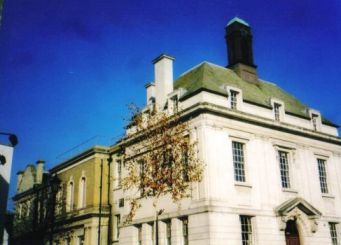
Trading was carried on in the road which at that time can have been little more than a track, until in 1560 it was so congested that an orchard was taken over behind the Crown Inn to provide a site for trading.
This is still called Market Place and is where the Magistrates Court now stands. A description of the town of New Brentford in 1593 called it 'Great' or 'Market' Brentford indicating its significance. The fact that Brentford is shown on maps of the period indicates its importance.
Abolished!
At the beginning of the 17th century the market lease was held by Jerome Hawley whose family was involved with its fortunes through several generations. They were engaged in a lawsuit for several years with Lady Anne Gresham, the widow of Sir Thomas Gresham of Osterley who had inherited the manor of Boston from her husband.
It would seem that at this time the Hawleys had not been paying the rent for some years so King James I abolished both the market and the fair. Many people in the area had livelihoods that depended on the trade it generated as did the prosperity of the town. They therefore petitioned the king for its restoration and a new lease was granted to James Hawley in 1610.
Brentford Market in the 17th century
The map drawn by Moses Glover in 1635 that hangs in Syon House shows New Brentford as a single row of buildings on each side of the road with buildings set back from the road at the market. 'Ye Lion' later the Red Lion is shown to the east and 'Ye Doves', later the Three Pigeons to the west.
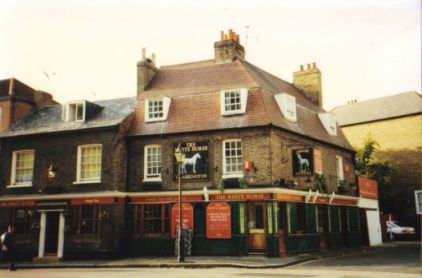
The White Horse, now called The Weir is said to have a license dating from 1603 but is not individually shown.
The Hawley interest in the market seems to have been sold in 1619 to Valentine Saunders of Chiswick for £3,350. On his death it was inherited by his 15 year old brother and shortly after was taken over again by the Hawleys.
Their charter was granted by Charles II who also gave permission for the holding of two six day fairs from 1st May and 1st September. The site was also enlarged as it was too confined for the sale of cattle and sheep. In 1666 (the year of the Great Fire of London) a Market House was also built and this appears on many old prints of the town.
The market was obviously a valuable local amenity and important to local prosperity with Mr Hawley's patent valued at £200 in 1653 when the whole manor of Boston, together with the house was only valued at £126.
In 1664 William Parish of the Red Lion had bought land on the Butts from the Boston estate for building and in 1679 Ann Parish obtained a grant for a weekly market there on Thursdays for the sale of cattle and pigs.
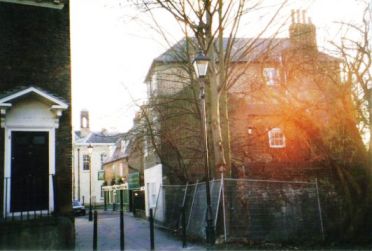
Thomas Faulkner writing in the 1840s pointed out that 'every person has a right to come on to the Butts and return with horses and carriages, but the way through the Castle yard and Market Place is private, the latter to be open only on market days'. James Clitherow of Boston Manor writing in the late 18th century told that as a favour his father had been allowed a key to the gate from the market place so that he could take a more direct route home.
The Castle, later the Harrow, was an inn in the High Street with a yard that ran through to the Butts where Caxton Mews now stands so that regular access to the Butts must always have been from Half Acre except on market days. Perhaps this is the historic reason why there is no road through to the Butts from the Market Place.
Old photographs show a gate across the path but now there are bollards.
Punishment - the stocks!
Court records of the 17th century tell of people being put in the stocks on market day as punishment for a variety of misdemeanours. In 1655 George Gumer was set in the stocks for profaning the Lords's day.
John Stibbs received the same punishment in 1706 for swearing. Unfortunately the record does not tell whether William Buck, the petty constable of New Brentford, being 'so in drink that he was unfit to execute his office' chose to pay 5/- rather than sit in the stocks.
'Frequented by the rabble'
By the end of the 17th century the fairs brought disturbance and noise to the town. A poem of the time by Samuel Butler called Hudibras gives glimpses of life at the time and mentions the fair at Brentford where the bear baiting was a popular activity. William Hogarth later illustrated the poem.
The fair must have created disturbance for many generations.

In 1816 John Quincey Adams the American Ambassador, later the 6th President of the United States who lived locally at the time narrowly avoided having his pocket picked and said that the fair was 'frequented by the rabble and children'. In 1845 Faulkner writes of 'the noisy sport and occasional disturbances there' and that people living nearby were trying, unsuccessfully, to get it closed.
Fred Turner in 1922 told the same story but it was not until 1933 that the fairs were eventually discontinued.
The market flourished through the 18th century being sold in 1768 by the last generation of Hawleys to Charles Woodcock, Robert Wallace Johnson and others including the Reverend Horne Tooke of St Lawrence's Church.
Local produce
Much of the produce sold was grown locally. The brickearth soils over well drained gravel beds had provided fertile land able to support a variety of crops for many generations and as London grew and expanded food needed to be grown closely enough to arrive fresh at the market and in the city.
The Roque map of 1745 shows that the town as a row of buildings along the High Street apart from Back Lane and Albany Road. It was surrounded by orchards, market gardens and fields growing fodder for horses and cattle. The islands in the Thames grew osiers and willows from which baskets were woven for transporting crops of fruit and vegetables.
Apple, pear, codling and quince
The first orchards were recorded in middle of the 16th century with market gardening increasing the area under cultivation from the late 16th century and taking over land earlier used for arable farming.
In 1673 it was reported that the 35 year old trees in the Great Orchard in Old Brentford were replaced with apple, pear, codling and quince trees. By 1711 mulberries, cherries, asparagus and strawberries were being grown on 5 acres of land in Boston Manor Road.
In 1802 the Ronalds family who cultivated land in The Butts, the Ham and in Isleworth grew 300 different types of apples and T.W.Beach won prizes for his locally grown strawberries at the Great Exhibition in 1851.
Brentford's market gardens
At this time there were approximately 3,000 acres of market gardens in and around Brentford known as the fruit and vegetable garden of London. As the capital had expanded through the centuries more and more fresh food was required for the growing population. As the city extended westwards the market gardens closer to London were built over. This led to land around Brentford becoming intensively cultivated through the 18th and early 19th centuries.
Low growing and soft fruits were grown underneath the fruit trees and fertilised with what was politely called 'night soil' and other refuse from London brought back in the carts and boats when they returned from their deliveries. This practise continued until early in the 20th century.
Horticulture was aided by the improvement of roads during the 19th century as it was dependent on easy, rapid transport to get their goods to market. Local growers also had an advantage as they could exploit a favourable market and bring fresh supplies into the market at short notice.
Seasonal workers from afar
Fruit and vegetable growing being a seasonal activity was dependent upon seasonal workers. Women workers came from Wales and Shropshire during the 18th century. In 1793 Thomas Baird writing his 'General View of the Agriculture of the County of Middlesex' pointed out that working in the open air was 'conductive to health' and preferable to spinning which women were employed at in other parts of the country.
A few years later John Middleton in his 'View of the Agriculture of Middlesex' pointed out that each acre of cultivated land employed a family of 5 in the winter and an additional 5 people in the summer 'chiefly Welsh women'. There were then market people, porters, basket women, dealers and hawkers plus their families making a total of 20 people employed per acre. He estimated that 35 inhabitants per acre were supported during the summer. This he estimated in money at £100 per acre or £3,000 pa.
At this time 3,000 acres were under cultivation with apples, pears, cherries, plums, walnuts, raspberries, gooseberries, currants, strawberries, shrubs and herbs being grown.
Later in the 19th century seasonal workers travelled from Ireland and many stayed and settled in England.
Other local industries
A flourishing market in corn in the town gave rise to the growth of malting, distilling and brewing in the late 17th century. Most malthouses were attached to breweries but a large distillery was developed by Sir Felix Booth north of the High Street near Ealing Road. By 1845 it was producing nearly 1 million gallons of spirit per year and was sold to Haighs shortly afterwards.

Thomas Faulkner in his book, 'The History and Antiquities of Brentford Ealing and Chiswick' writing in 1845 tells of the Tuesday market where meat, poultry, butter, cheese, eggs, fruit, vegetables, green house plants, hardware and brushes, earthenware and glass, fish, geese and pigs, books and paints were sold and so, it was said, 'looked more like a fair than a market'.
It was obviously an asset to the town as he wrote of the High Street 'The western end makes a very respectable and businesslike appearance, being lined on both sides with good shops and the weekly recurrence of the market greatly adds to the traffic and convenience of the town'
Shortly after this the Market House was demolished and a Town Hall built as a speculative development. It was never used as a Town Hall but over 40 years housed Magistrates Courts, a library and reading room, several banks, shops and meeting facilities used for public entertainments.

The Brentford Local Board met there until they moved to Clifden House and in 1891 it was purchased by the Middlesex County Council for use as a full time Magistrates Court. With some additions the building is still in use in 2009 and the area still called Market Place.
The Kew Bridge site
Meanwhile, a fruit and vegetable market was growing up in the roadway at the foot of Kew Bridge where growers were trading from their carts.
The story goes that a grower, on his way to Covent Garden (the main London market at the time), had stopped for a drink at the Express Tavern opposite Kew Bridge when a passer by asked if they could buy some of his bunches of turnips.
On his next journey a group of people had gathered to buy from him and realising that he could save himself a journey into London he made arrangements to trade on the forecourt of the Express Tavern. Other growers realising they could save themselves the time and effort of travelling in to London stayed at Kew Bridge and more and more buyers gathered.
A fountain that had been erected there in 1877 by the Metropolitan Drinking Fountain and Cattle Troughs Association provided a focus for trading. The foundation stone of the fountain had been laid by the Duchess of Teck who lived at Kew Green.
From 'nuisance' to new market
 By 1890 the informal and illegal trading by at least 60 wagons around the fountain was becoming a nuisance, causing congestion and blocking the road.
By 1890 the informal and illegal trading by at least 60 wagons around the fountain was becoming a nuisance, causing congestion and blocking the road.
A Mr Bush QC of Kew Green complained to the Metropolitan Police about the delays he experienced getting to Kew Bridge Station for his train and was referred to the Brentford Local Board who were, at that time responsible for the administration of the town.
There was a great deal of controversy and disagreement about these plans.
It was suggested by opponents of a purpose built market that the town would be saddling itself with a white elephant but the Local Board went ahead and bought 2 acres of land from the Rothschild estate east of Kew Bridge and north of the road at Gunnersbury to provide a market site. The traders were consulted about the facilities they would require and all the stalls were taken before the opening on 24th May 1893.
Opening ceremony, 1893
A special supplement of the Middlesex Independent at the time reported that the official opening day was treated as a general holiday with most business establishments closing at mid-day.
Premises along the High Street, where the official procession of local dignitaries travelled, were decorated in a way not attempted since Queen Victoria's Golden Jubilee and the tenants of Stile Hall Parade opposite the new market let out their windows for viewing of events at 1/- (5p) per head.
Alderman Knill, the Lord Mayor of London, performed the official opening ceremony. He unlocked the gates and was greeted by a volunteer band and a salute of fog signals fired off on the North London railway running at the rear of the site. The official speeches stressed the excellent links to and from all parts of the country by rail from the market and the prosperity it was expected would come to the town. [The ceremony described in the Middlesex Independent is captured in this photo].
A banquet was held at the Princes Hall, near Kew Bridge during the evening. There were toasts and speeches. It was pointed out by Robert Addey, a local grower, that there had been disagreements about the building of the market but that it had been achieved without a farthing on the rates. He said that there were sufficient rents in hand to cover the working expenses for 12 months and repay instalments of the loan and interest.
The site had been an irregular shaped piece of land of approximately 2 acres and contained covered stalls surrounded by wagon stands. The engineer responsible for the building had been John Henry Strachen who was the surveyor to the Brentford Local Board.
Expansion plans at the end of the 19th century
Business increased and in 1897 a newly appointed surveyor, Nowell Parr, was instructed to prepare plans and estimates for laying out an extension next to the original site. The dues in 1893 were £1,200 and had increased to £3,000 by the time the extension opened in 1906.
The Market Committee visited markets in other parts of the country to see what they could learn from their organisation. By 1902 Lord Rothschild had agreed to sell the necessary land and in 1904 J. Dorey and Co of Brentford had been awarded the contract to build the market extension for £43,302. Interestingly, Mr Dorey was on the Market Committee and a local Councillor at the time.
Leopold de Rothschild laid the foundation stone on 18th September 1905 and the work was finished six months ahead of schedule leading to the chance of an extra six months rent and a saving of £2,000. When Nowell Parr was complimented on this he is said to have replied that he was only doing his duty.
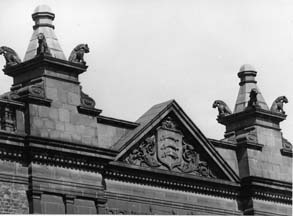
Like other Parr buildings in the town the extension was built in Flemish style with brick and terra cotta decorations and increased the market to a site of 11 acres with three covered avenues, space for wagons in the centre and ordinary stands at the sides. There were five auction spaces, a large refreshment area and 14 shops fronting the High Road. The Middlesex Independent described it in 1906 as 'the latest and most palatial market in Britain'.
A snapshot from 1927 to 1936
In 1927 a report by the Ministry of Agriculture and Fish on fruit marketing in England said that there were 700 buyer's carts entering the market every day. It pointed out that the fruit and vegetables being sold were all from market gardens in Middlesex and that any choice and expensive fruits required were obtained by buyers at Covent Garden, the main market in the country at the time.
It did not seem to have been noticed that with the opening of the Great West Road to bypass Brentford High Street in 1925, factories and houses were gradually being built on the fertile orchards and market gardens near to the market.
A report on markets and fairs was published in 1929 when the freehold had been taken over by the Brentford & Chiswick Urban District Council. It stated that the road approaches to Brentford Market were excellent and that the organisation of the three internal avenues with three transverse roads being a one way system meant that there was no internal congestion. There were 62 lock up stalls rented at 6d per square yard per week, 110 pitching stands where goods were pitched off wagons to be sold on the stand and 20 wooden shops on the outskirts of the enclosure.
At that time there were 260 growers regularly bringing produce from Middlesex, east Surrey, east Buckinghamshire and east Berkshire. Most of the transport, by this time, was motorised but there was still stabling for 200 horses.
The area supplied by the market was a 7 mile radius extending from Hammersmith to Staines and Windsor. The principal market days were Monday, Wednesday and Friday although it was open every weekday at 6am. The entrance toll was 2d to 4d per vehicle and merchants engaged their own porters. Six more acres of land had been acquired and plans had been made to extend the site as trade was still expanding.
The bylaws in 1936 show that meat, poultry and game were being sold and that some horses were still being used as the rules stated that they had to be stabled during trading. Stalls had to be cleaned before and after the sale of goods. Refuse, filth, rubbish and litter had to be removed. Hawking, disorderly behaviour and canvassing were prohibited and dogs were to be kept on leads.
The picture in 1968

By 1968 the site covered 11 acres with some land having been sold for building Chiswick roundabout, a garage and the telephone exchange in Wheatstone House. The London Borough of Hounslow who was then the freeholder commissioned a report on the market. This pointed out that the site at the junction of the North and South Circular Roads, the A4 and the M4 was an ideal situation to serve west London. This was also a disadvantage as it was an area of congestion that was made worse by market traffic that left through the only entrance on Chiswick High Road between 8am and 9.30am. The traffic during the rush hour was therefore being increased.
The Council, it continued, was responsible for the external repairs and the tenants, who had formed the Brentford Wholesale Market Tenants Association were responsible for interior repairs. There was a branch of the Retail Fruit Trade Federation who acted on behalf of the retailers and the Brentford Market branch of the Transport and General Workers Union who represented the porters.
The site included a bank, restaurant, barbers and clothing shops, a blacksmith, an eel stall, a florist sundries stand and one selling the equipment required by retailers. There were casual stands for the sale of seasonal goods such as Christmas trees. The car park was used for car club events, driving tests and gymkhanas at weekends and by the time of the 1968 report was considered 'completely unsuited to the needs of the modern pattern of trade and its associated problems'
One of the main problems was transport.
In 1927 22,200 retailers 2 wheeled vehicles (mostly handbarrows) entered the market and 135,600 4 wheeled vehicles. By 1967 this had changed to 449 2 wheeled and 252,115 4 wheeled. The site also needed to cope with refrigerated containers up to 45 feet long which were 8 feet high and 8 feet wide and were unable to manoeuvre in the restricted spaces built for horses and carts.
1970s - a new market for Brentford
An important decision was made to move the market to give up to date facilities and opportunities for expansion. A new site was then acquired at North Hyde on the borders of Southall which could provide the improved links with the road network that were necessary for the expansion and improvement of the market. At a ceremony in 1972 Jack Nash who was thought to be the longest serving porter cut the first turf of the 36acre, £2million plus site. He had started as a banana boy in 1912 and returned after World War I as a horse car man and later became one of the first motor drivers. He was accompanied by Tom Collins, a 16 year old warehouseman who had only started work the previous July. |
 |
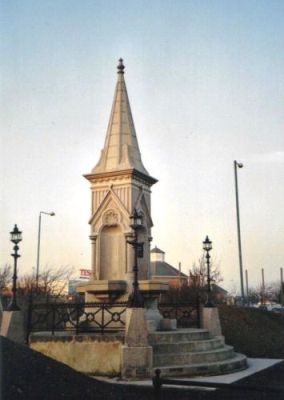 |
The new Western International Market opened in 1974 thus ending nearly 700 years of market trading in Brentford. Until it was redeveloped the empty site was used for one of the earliest Car Boot Sales and Sunday markets in the area. A skateboard park filled the covered part of the site and one of the shops was used on Saturdays by Friends of the Earth as an environmental advice centre and collection point for waste paper. Where the market stood is now the site of Capital Interchange Way and the Fountain Leisure Centre to the west of Chiswick Roundabout. The Leisure Centre was named to commemorate the drinking fountain that stood for many years at the foot of Kew Bridge. It was moved to Western International Market in 1974 and after a rebuild of the market in 2008 it has been repaired and refurbished and marks the present entrance to the market. It still boasts of its good transport links being 2 minutes from the M4, 4 minutes from the M25 and 5 minutes from Heathrow Airport. Other memorabilia of the market are said to be in the Leisure Centre and at Western International Market and the tiles from the front in Capel Manor gardens at Gunnersbury Park. |
Sources
Victoria County History, available online, for example Ealing and Brentford: Economic history
Brentford Journal of court records
The History and Antiquities of Brentford by Thomas Faulkner
The Environs of London (Vol II part I) by Rev D Lysons
The History and Antiquities of Brentford by Fred Turner
General View of the Agriculture of the County of Middlesex by Thomas Baird 1793
View of the Agriculture of Middlesex by John Middleton 1807
The Horticulture industry of Middlesex by L G Bennett PhD University of Reading 1952
English Towns in Transition 1500 - 1700 by Peter Clark and Paul Slack OUP 1976
2,000 years of Brentford by Roy Canham
Report on Markets and Fairs 1929
1968 Report by G R Churchhouse ARICS AAI
1972 The New Brentford Market
Middlesex Independent (Edition of 27th May 1893)
The Gardeners Magazine (Edition of 30th May 1905)
Nowell Parr by D G Eke
Brentford in Archive Photographs by Carolyn and Peter Hammond
The History of the Great West Road by James Marshall ALA
Links
The site has several postcard images showing the market at its original location, for example this one from the early 1900s. Use the search facility from the home page to find more.
Claire Noble undertook an analysis of Brentford Market traders who lived outside the local area: read more.
Published July 2009; last updated June 2024